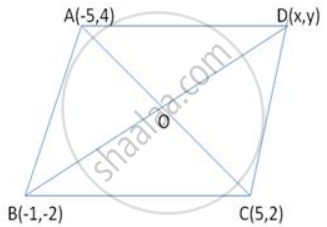Advertisements
Advertisements
Question
Prove that the points A(-5, 4), B(-1, -2) and C(S, 2) are the vertices of an isosceles right-angled triangle. Find the coordinates of D so that ABCD is a square.
Solution

AB = `sqrt ((-1 +5)^2 (-2-4)^2) = sqrt (16+36) = sqrt 52` units
BC = `sqrt ((-1 - 5)^2 + (-2-2)^2) = sqrt (36 + 36) = sqrt 52` units
AC = `sqrt ((5 + 5)^2 + (2 - 4)^2) = sqrt (100 + 4) = sqrt 104` units
AB2 + BC2 = 52 + 52 = 104
AC2 = 104
∵ AB = AC and AB2 + BC2 = AC2
∴ ABC is an isosceles right angled triangle.
Let the coordinates of D be (x , y)
If ABCD is a square ,
Midpoint of AC = mid point of BD
O`((-5 + 5)/2 , (4 + 2)/2) = "O" (("x" - 1)/2 , ("y" - 2)/2)`
O = `("x" - 1)/2 , 3 = ("y" - 2)/2`
x = 1 , y = 8
Coordinates of D are (1 , 8)
APPEARS IN
RELATED QUESTIONS
The line joining the points (2, 1) and (5, –8) is trisected at the point P and Q. If point P lies on the line 2x – y + k = 0, find the value of k. Also, find the co-ordinates of point Q.
M is the mid-point of the line segment joining the points A(0, 4) and B(6, 0). M also divides the line segment OP in the ratio 1 : 3. Find :
- co-ordinates of M
- co-ordinates of P
- length of BP

A(–4, 2), B(0, 2) and C(–2, –4) are vertices of a triangle ABC. P, Q and R are mid-points of sides BC, CA and AB respectively. Show that the centroid of ΔPQR is the same as the centroid of ΔABC.
Find the image of the point A(5,3) under reflection in the point P(-1,3).
Find the image of the point A(5,3) under reflection in the point P(-1,3).
The line segment joining A (2, 3) and B (6, – 5) is intersected by the X axis at the point K. Write the ordinate of the point K. Hence find the ratio in which K divides AB.
Show that the points A(1, 3), B(2, 6), C(5, 7) and D(4, 4) are the vertices of a rhombus.
= `a(1/t^2 + 1) = (a(t^2 + 1))/t^2`
Now `(1)/"SP" + (1)/"SQ" = (1)/(a(t^2 + 1)) + (1 xx t^2)/(a(t^2 + 1)`
= `((1 + t^2))/(a(t^2 + 1)`
`(1)/"SP" + (1)/"SQ" = (1)/a`.
If the line joining the points A(4, - 5) and B(4, 5) is divided by the point P such that `"AP"/"AB" = (2)/(5)`, find the coordinates of P.
In the following figure line APB meets the X-axis at A, Y-axis at B. P is the point (4, -2) and AP: PB = 1: 2. Write down the coordinates of A and B.
Determine the centre of the circle on which the points (1, 7), (7 – 1), and (8, 6) lie. What is the radius of the circle?
